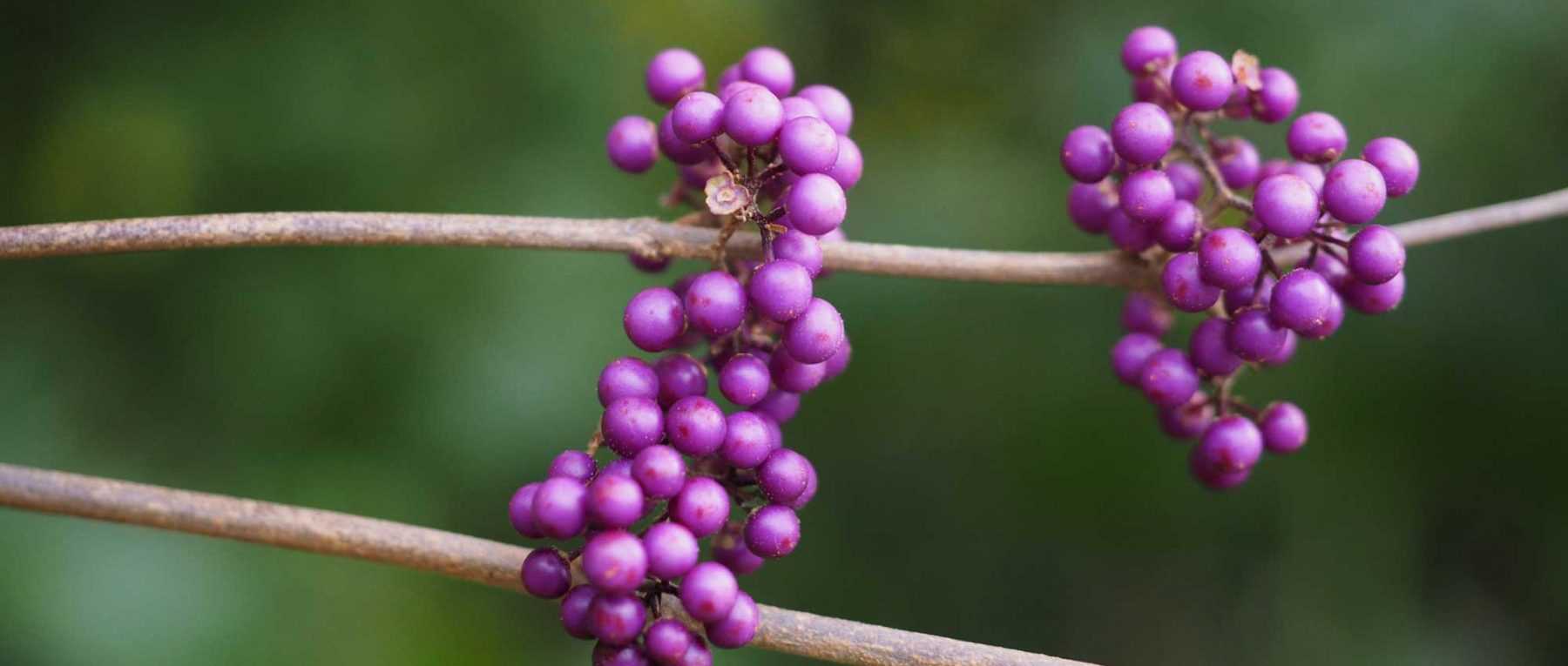
Callicarpa: Planting, Growing and Caring
Contents
The Callicarpa in a few words
- With its violet berries, the Callicarpa is an unusual shrub that brings colour and brightness in autumn!
- Easy to grow, it requires little maintenance! It is rarely attacked by diseases or pests.
- It has ordinary foliage and discreet flowers… but these are followed by spectacular fruiting!
- Its very natural appearance makes it an ideal shrub for a country hedge or the back of a flower bed.
- Although known for its purple fruits, there are also varieties with white berries.
- The foliage often takes on lovely colours in autumn!
Our Expert's Word
Also known as the Beautyberry, the Callicarpa is a stunning small shrub that brings autumn to life with its surprising purple berries! Although the most common variety is the Callicarpa bodinieri ‘Profusion’, there are many other species, such as Callicarpa japonica, Callicarpa americana or Callicarpa dichotoma… At first glance, the Callicarpa is a rather ordinary shrub. Its foliage is simple, its flowers are pretty but discreet – from a distance, they hardly stand out… but they are followed by magnificent berries that bring colour right in the heart of autumn! This is truly the season this shrub has chosen to reveal its full beauty, often with foliage adorned in lovely golden, orange or purple hues depending on the variety. Its berries resemble pearls – rounded and glossy, with stunning shades that bring dynamism and brightness to autumn! You can use berry-covered branches to incorporate into bouquets!
The Callicarpa is an easy-to-grow and low-maintenance shrub! It never suffers from diseases or pest attacks. It thrives in sunny spots, in fresh, well-drained soil. You can plant it in a mixed hedge or at the back of a flower bed, alongside other shrubs with decorative berries or colourful autumn foliage. We recommend grouping several Callicarpa plants together to encourage pollination and, consequently, fruiting. Pruning the Callicarpa helps maintain a harmonious and compact shape, but it can also do perfectly well without. It can be propagated by seed or cuttings.
Botany
Botanical data
- Latin name Callicarpa sp.
- Family Lamiaceae
- Common name Beautyberry, Bodinier's Beautyberry
- Flowering summer
- Height Up to 3 metres.
- Exposure Sun or partial shade.
- Soil type ordinary, but fresh and well-drained.
- Hardiness Generally down to –15°C. Slightly less for some varieties.
Beautyberries are trees or shrubs primarily native to East Asia (China, Korea, Japan, Vietnam, Taiwan…). Thus, Callicarpa bodinieri originates from China and was introduced to France in the late 19th century. Other Callicarpa species are native to North or South America, such as Callicarpa americana, which comes from the southeastern United States (Florida, Virginia, Louisiana, Texas…). Some species are even found in Australia and Madagascar! In the wild, beautyberries mainly grow in forests. Species from tropical forests are evergreen, while those we cultivate in our gardens, from temperate zones, are deciduous.
Beautyberry belongs to the Lamiaceae family. This is a large family, comprising over 6,000 species of plants with simple, opposite leaves, often toothed, with irregular flowers… These are generally fragrant plants, widely used for their medicinal or aromatic properties, such as Sage, Mint, Thyme or Lavender. It also includes other ornamental shrubs, like Caryopteris or Clerodendron. Beautyberry was formerly classified among the Verbenaceae, the family of verbena and lantanas.
There are nearly 170 species of beautyberry. Despite this large number of species, essentially one variety is found in garden centres, Callicarpa bodinieri ‘Profusion’, which is far more widespread than all others! This variety has been favoured because it offers very generous fruiting and is rather robust, with good hardiness.
Etymologically, beautyberry owes its name to the beauty of its berries: in Greek, kallos means beautiful, and karpos: fruit. In English, it is called BeautyBerry, which means the same thing, “pretty berries”. In French, it is also popularly known as the “Candy Bush”.
Beautyberries are shrubs that can reach up to three metres in height. Some are more compact, like Callicarpa dichotoma ‘Issai’, which reaches about 1.20 m tall. Beautyberries often have rather irregular shapes and are roughly as wide as they are tall. Their branches are generally quite long and curved. This is what gives Callicarpa dichotoma its particularly elegant habit, with long, drooping branches. Beautyberry stems are pubescent, covered with small hairs, as is the underside of the leaves.
In midsummer, around July, beautyberry bears rather inconspicuous flowers, sometimes hidden by the leaves. They are grouped in small, dense cymes, usually three to four centimetres in diameter, located in the leaf axils. The flowers are pretty but discreet… From a distance, they are hardly noticeable. They consist of a four-lobed corolla (fused petals), often soft pink, with four long yellow stamens protruding. The flowers are white in Callicarpa japonica ‘Leucocarpa’ (like the fruits). In other varieties, they can take on red or purple hues. Most beautyberries are hermaphroditic.
In autumn, from October onwards, beautyberry impresses with its berries, shiny and perfectly round, with superb colours! They resemble marbles, with metallic reflections. They are often pink or purple… with the exception of Callicarpa japonica ‘Leucocarpa’, which has white berries! They are usually 3 to 4 mm in diameter. They are clustered around the branches in small, dense groups. They are pressed close to the stems, as their peduncle is very short.
They are not edible, neither for us nor for birds, which fortunately ignore them! They can thus remain on the shrub for a long time… usually until December! They stay in place after the foliage falls, allowing us to fully enjoy them. Each berry contains four small seeds. They sometimes germinate spontaneously at the base of the shrub.
Beautyberry foliage is rather ordinary. As with other Lamiaceae, the leaves are entire, simple, with toothed edges, and arranged oppositely on the branches. They have small hairs on their underside.
However, beautyberry leaves take on very beautiful colours in autumn! They are adorned with yellow, orange, red or purple hues. The foliage of Callicarpa rubella is remarkable as it turns pink in autumn, while that of Callicarpa japonica becomes golden with touches of purple! When it takes on bright hues at the end of the year, the foliage creates a superb contrast with the purple berries. Sometimes, it’s the young leaves that are interesting for their colours, like those of Callicarpa bodinieri ‘Profusion’, tinged with bronze. There is even a variety with leaves marbled with white, Callicarpa japonica ‘Koshima-no-homate’, but it is quite rare in cultivation.
The beautyberries we cultivate in our gardens are deciduous shrubs, losing their leaves in winter, while other species, native to tropical regions, are evergreen.
Botanical species:
- Callicarpa bodinieri
By far the most cultivated beautyberry, especially the variety ‘Profusion’! It is remarkable for its generous flowering and good hardiness. It originates from China and was introduced to France in the late 19th century.
- Callicarpa dichotoma
This is the most elegant beautyberry! It is not very tall but has long, drooping branches that give it a particularly graceful habit. Its leaves turn red in autumn. It will need protection in colder regions, as it is more fragile than Callicarpa bodinieri ‘Profusion’.
- Callicarpa kwangtungensis
This beautyberry has white-pink flowers, followed by violet-pink berries. Its leaves, finer and longer than other species, take on very beautiful colours.
- Callicarpa japonica
This is a rather compact beautyberry, not exceeding 1.50 m in height. It takes on superb hues in autumn, its foliage then becoming golden with purple nuances.
- Callicarpa americana
This species, native to the southeastern United States, has, like Callicarpa dichotoma, long, drooping branches that give it a very elegant appearance. It bears pretty pink-purple berries in autumn.
The main varieties of Callicarpa
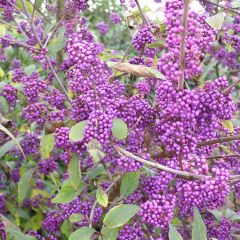
Callicarpa bodinieri var. giraldii Profusion
- Flowering time July to September
- Height at maturity 2,50 m
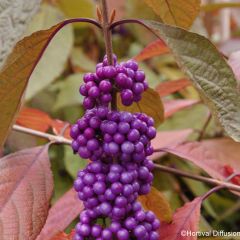
Callicarpa bodinieri Imperial Pearl
- Flowering time July to September
- Height at maturity 2 m

Callicarpa dichotoma Albibacca
- Flowering time July, August
- Height at maturity 1,40 m

Callicarpa dichotoma Issai
- Flowering time July, August
- Height at maturity 1,25 m
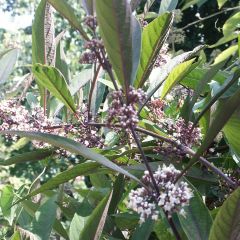
Callicarpa kwangtungensis
- Flowering time August, September
- Height at maturity 1,50 m
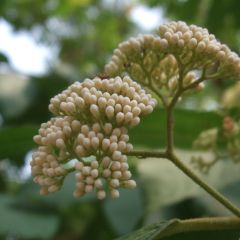
Callicarpa japonica Leucocarpa
- Flowering time September, October
- Height at maturity 1,50 m
Discover other Callicarpa
Planting Callicarpa
Where to Plant?
Plant your Callicarpa preferably in full sun. This will encourage fruiting. In northern France, it’s best to place it in full sun, while if you live in the South, partial shade will suit it perfectly! It tolerates lightly shaded positions as long as there is enough light, which is essential for good flowering and fruiting.
It enjoys moist soils that don’t dry out too much, even in midsummer. It’s advisable to add a layer of mulch around the base to retain moisture. The soil should also be relatively light and well-draining to prevent waterlogging, which can cause root rot. If your soil is heavy or clay-based, don’t hesitate to mix in materials to improve drainage: gravel, coarse sand, pumice…
Callicarpa isn’t overly sensitive to pH but dislikes overly chalky soils. It thrives in organically rich soils, so we recommend adding compost at planting time and then once a year in spring. It’s also best planted in a sheltered spot, protected from strong winds.
We suggest planting it near your house, perhaps opposite a window, so you can easily enjoy its winter display without having to venture to the far end of your garden!
When to Plant?
The best time to plant your Callicarpa is in autumn, during September or October. It can also be planted in spring. The key is to avoid planting during frosty periods.
How to Plant?
It’s best to group several Callicarpa plants together rather than planting them singly. This helps with pollination, increasing the chances of abundant berries. In any case, the visual impact will be far more striking with multiple shrubs planted together!
- Soak the root ball in a bucket of water to rehydrate it and aid establishment.
- Dig a planting hole, ideally three to four times larger than the root ball. We recommend adding well-rotted compost, especially if the soil is poor. If your soil is heavy or clay-based, add a drainage layer (gravel, pumice…).
- Position the root ball, ensuring the shrub stands upright.
- Backfill with soil and gently firm it down.
- You may wish to add a stake, particularly if the shrub is already quite tall.
- Water thoroughly, then apply a layer of mulch around the base (leaf mould, wood chips…). This helps retain soil moisture.
Continue watering regularly in the weeks following planting.
Maintenance
The callicarpa is an easy-to-grow shrub that requires very little maintenance. It rarely gets sick and is practically never attacked by pests! We recommend applying a layer of mulch at its base to preserve soil moisture. Initially, it’s best to water young callicarpa plants about once a week. When they’re more mature, they show good drought resistance. We also suggest adding some well-rotted compost in spring as callicarpas prefer fairly rich soils. During the first few years, you may want to protect it from cold, especially if you’re growing species other than Callicarpa bodinieri ‘Profusion’. Spring frosts may damage young shoots. Callicarpas are more sensitive to cold when still young.
Callicarpa can do perfectly well without pruning. However, you may carry out formative pruning during the first few years to create a balanced and harmonious shape. In subsequent years, when the shrub is more established, you can perform maintenance pruning. Remove any damaged, misshapen or poorly positioned branches. Pruning callicarpa will also help control its growth to maintain a compact habit, which is useful if your garden is small. Prune in early spring, around April.
Propagation
Callicarpa can be propagated by seed or by cuttings. We recommend cuttings to ensure you get a plant identical to the original. Seed propagation is best reserved for botanical species.
Seed Propagation
Callicarpa is easily propagated from seed in spring or autumn. It’s best to remove the pulp from the fruit, keeping only the seeds. Dry them and store in a cool, dry place before sowing.
- Start by soaking the seeds in water for 24 hours.
- Prepare a pot with a mix of compost and sand.
- Sow the seeds.
- Gently firm the soil and water.
- Place the pot in a warm, bright spot.
Keep the growing medium moist until germination.
Seeds may take two to three months to germinate. You can repot them, but we recommend keeping them in a pot for a year before planting them in the garden.
Cuttings
You can take semi-hardwood cuttings in summer.
- Fill a pot with compost mixed with a little sand.
- Take a 10 cm cutting from the tip of a healthy branch.
- Make a clean cut just below a node (where leaves attach to the stem).
- Remove the lower leaves, keeping only two at the top.
- We recommend dipping the base in rooting hormone to encourage rooting.
- Plant the cutting in the growing medium.
- Firm the soil to remove air pockets and ensure good contact.
- Water.
- Cover the pot with a plastic bag or bottle to maintain humidity. Ventilate occasionally to prevent fungal growth.
- Place the pot in a warm, bright spot but out of direct sunlight.
Keep the growing medium moist until the cutting establishes.
→ Learn more about Callicarpa propagation with Virginie’s tutorial!
Association
The beautyberry is perfect for creating a stunning autumn scene, in soft and warm tones dominated by purple, pink, mauve, violet, orange, and gold hues… You can draw inspiration from this autumnal theme!
Pair it with autumn-flowering plants! You can plant it alongside Persicaria amplexicaulis (such as the variety ‘Pink Elephant’) or Sedum ‘Autumn Joy’. Some asters also bloom until November, like Aster novae-angliae ‘Herbstschnee’ or Aster divaricatus. To add brightness, choose rudbeckias (such as Rudbeckia triloba), coreopsis, or chrysanthemums. If you live in a mild climate, enjoy the vibrant blooms of Schizostylis coccinea. For lightness, add ornamental grasses like pennisetum or miscanthus to your border.
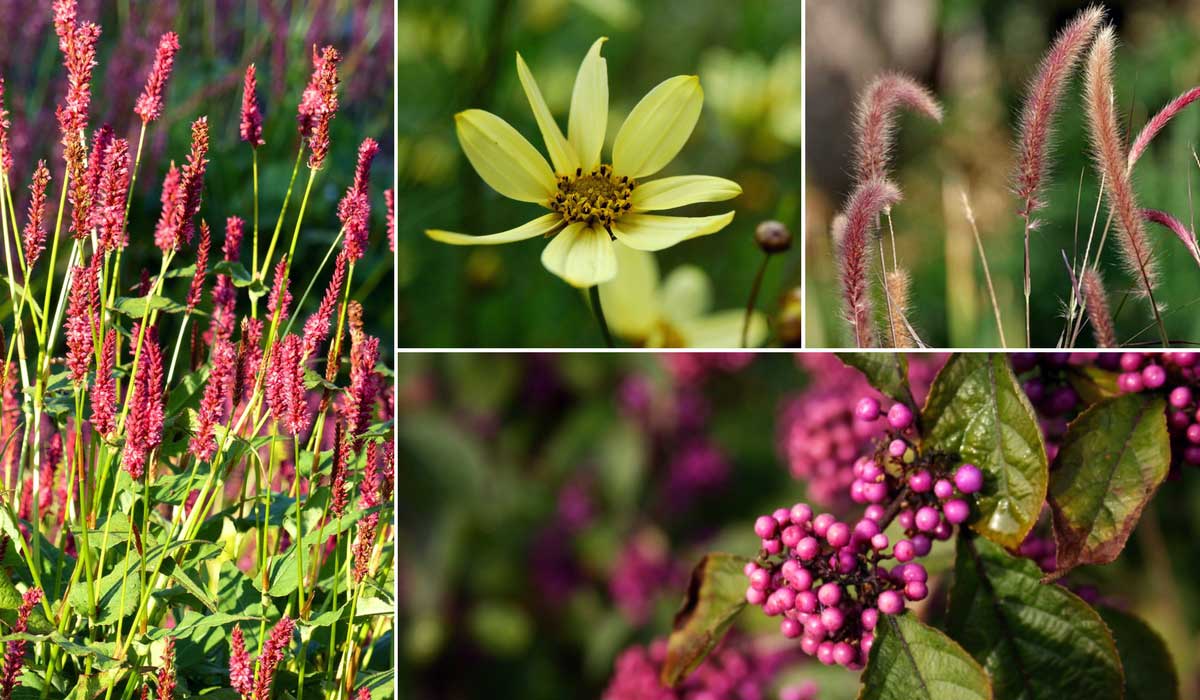

Pair your beautyberry with autumn blooms! Persicaria amplexicaulis ‘JS Delgado’, Coreopsis verticillata ‘Moonbeam’, Pennisetum setaceum, and Callicarpa bodinieri (Photo: Sten)
Incorporate your beautyberry into a mixed hedge with other berry-bearing or decorative-foliage shrubs. Many shrubs offer brightly coloured berries in late autumn! For a soft pairing, choose snowberries with their delicate pink or white berries. Enjoy the European spindle, Euonymus europaeus, which boasts not only decorative fruits but also fiery autumn foliage! Create striking contrast by combining the purple berries of beautyberries with the orange berries of pyracantha or sea buckthorn, Hippophae rhamnoides… or with the red berries of cotoneasters! Also consider ornamental crabapples. Finally, plant your beautyberry near pheasant berry, Leycesteria formosa, whose berries remain decorative well into late autumn.
Don’t hesitate to pair it with other shrubs renowned for their autumn foliage: Acer palmatum, Viburnum, Cornus… Enjoy the delicate, airy foliage of sacred bamboo, Nandina domestica, which turns red in late autumn. The beautyberry also pairs beautifully with shrubs prized for their decorative stems, such as Cornus sanguinea or Cornus alba ‘Sibirica’! The purple berries will perfectly complement the red or orange stems of dogwoods, creating a vibrant and luminous display.
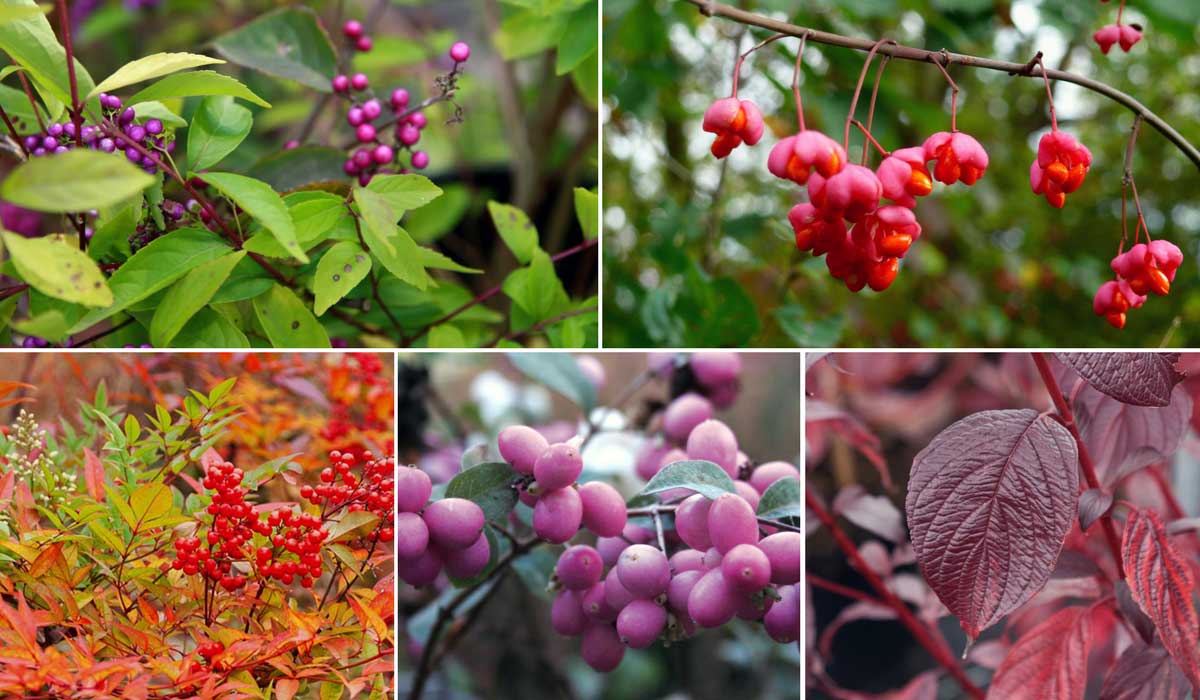

Callicarpa bodinieri ‘Profusion’ (Photo: David J. Stang), Euonymus europaeus, Nandina domestica, Symphoricarpos ‘Magical Candy’, and Cornus alba ‘Siberian Pearls’
You can also plant them with other beautyberries! Feel free to mix different varieties with berries of contrasting colours—for example, pairing the purple berries of Callicarpa bodinieri ‘Profusion’ with the white berries of Callicarpa japonica ‘Leucocarpa’. Grouping beautyberries will result in more abundant fruiting, as pollination is improved.
Did you know?
- A callicarpa as a bonsai!
It is possible to train callicarpa as bonsai. You’ll get a truly spectacular dwarf shrub in autumn! The most commonly used species is Callicarpa japonica.
Useful resources
- Discover our range of Callicarpa!
- Discover 5 Callicarpa planting companions
- Our video guide: How to plant a shrub
- An article by Michael on our blog: The best ornamental shrubs with decorative berries
- Learn more about plants with toxic berries
Frequently asked questions
-
My Callicarpa produces very few berries. Why?
The fruiting of Callicarpa is less abundant when planted alone, as they struggle with self-pollination. It's better to group them together to encourage pollination, thereby increasing the chances of a plentiful berry display! If your shrub produces few fruits, it might also be due to a location that's too shady... It needs sunlight, and above all, good light exposure to ensure generous flowering followed by abundant berries. Long, hot summers greatly enhance fruiting. Lastly, we recommend choosing varieties such as Callicarpa bodinieri ‘Profusion’ or Callicarpa bodinieri ‘Imperial Pearl’, as their fruiting is more prolific compared to other varieties.
-
My Callicarpa is growing slowly and lacks vigour... What should I do?
The callicarpa thrives in relatively rich soils, which is why we recommend adding compost in spring. Additionally, overly compacted soil can hinder the shrub's growth. It's best planted in light, well-aerated soil, or you can incorporate drainage materials during planting: gravel, coarse sand, pumice... Finally, you can also prune it in early spring to encourage growth.
- Subscribe!
- Contents
. Callicarpa, the Candy Tree: Planting, Pruning, and Care](https://en.promessedefleurs.eu/blogwp/wp-content/uploads/2018/10/callicarpa-_-tout-savoir.jpg)


































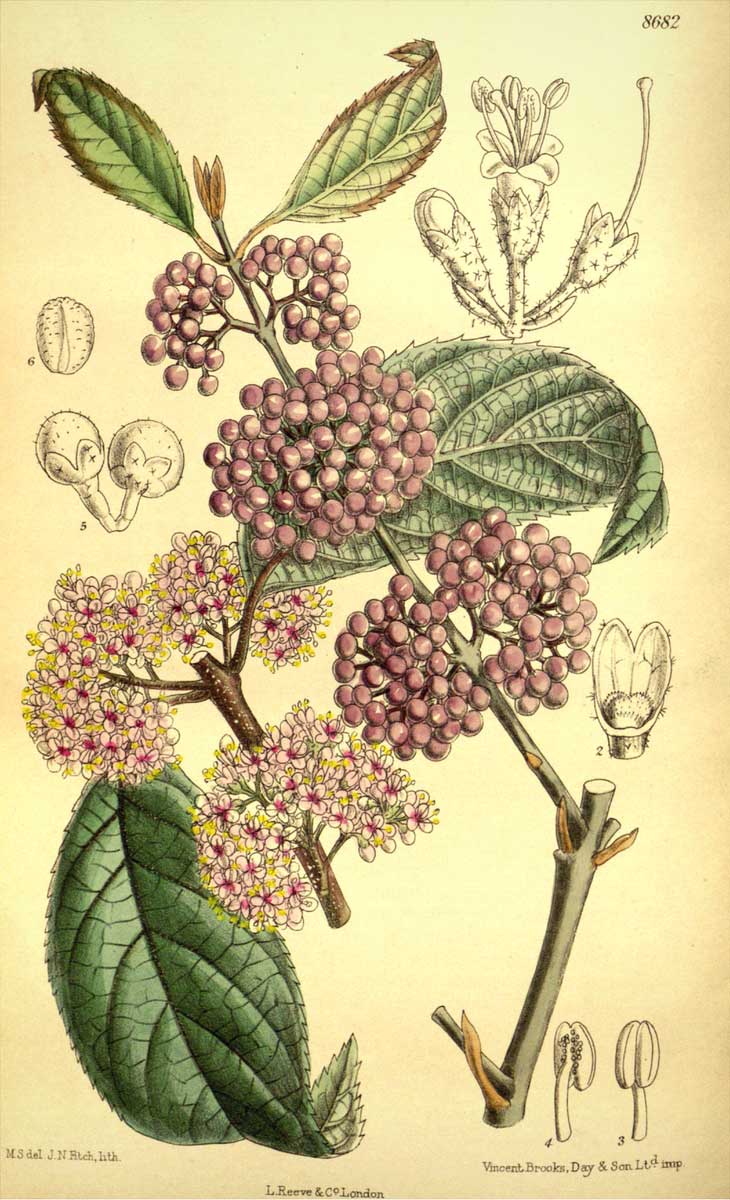
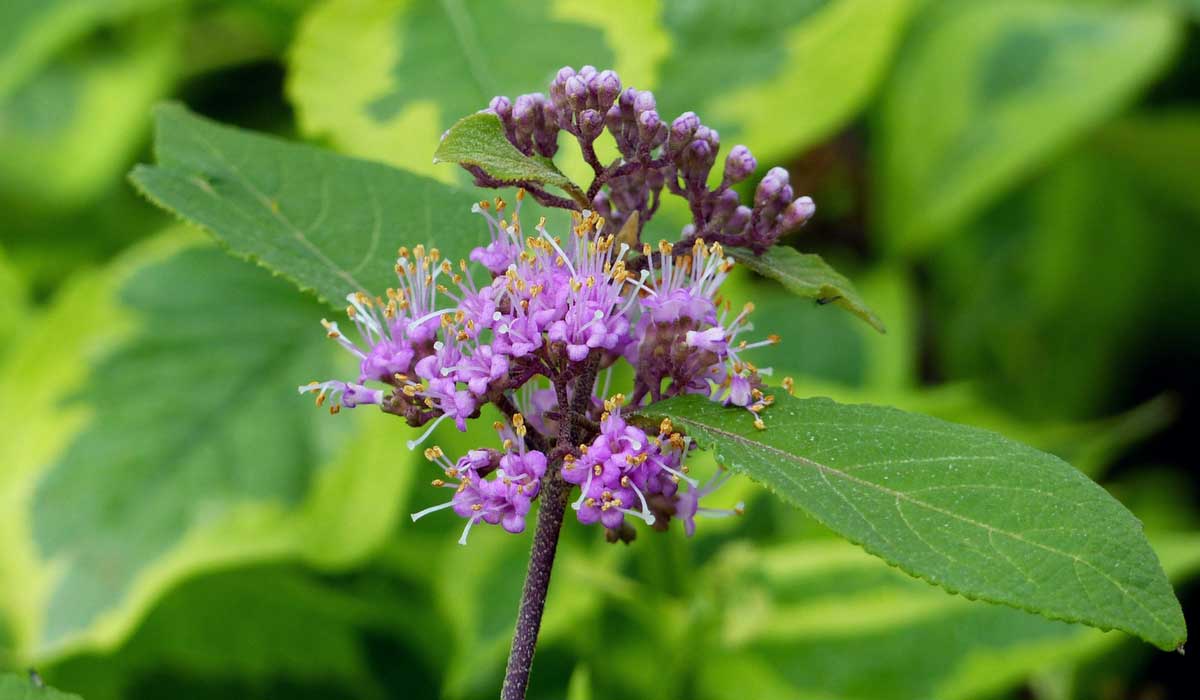

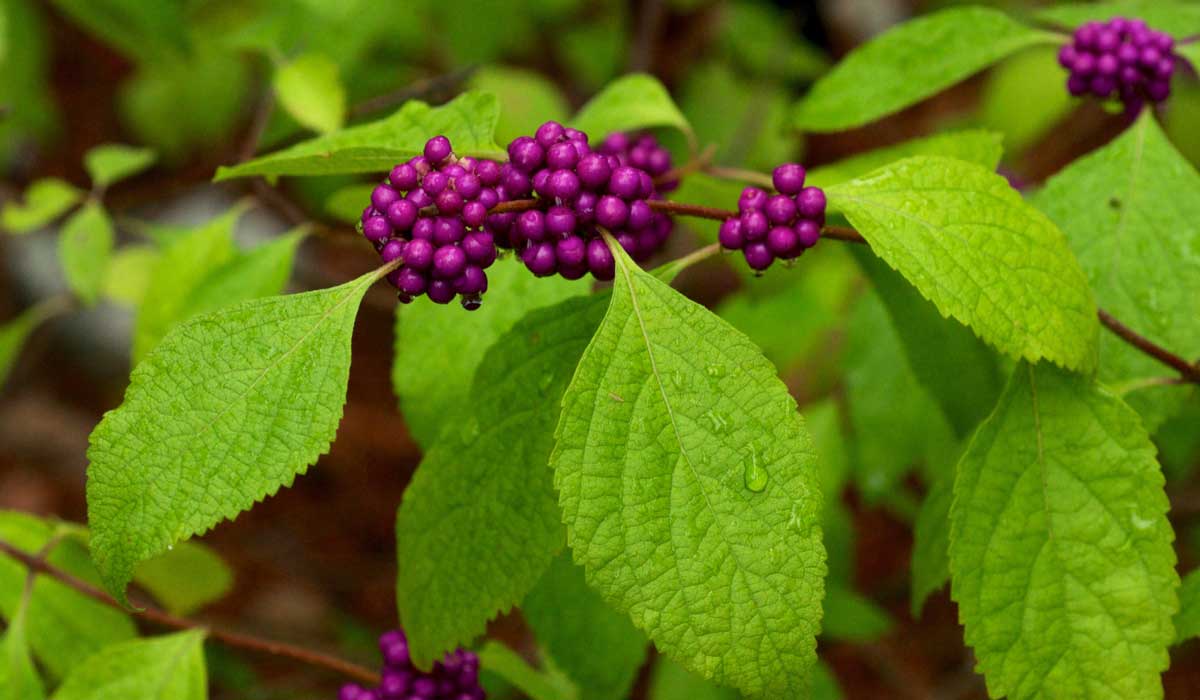





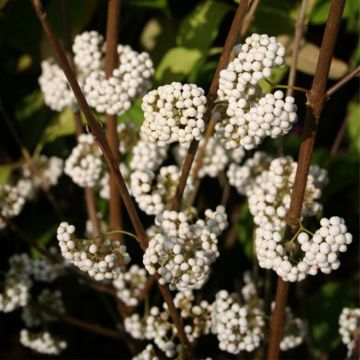
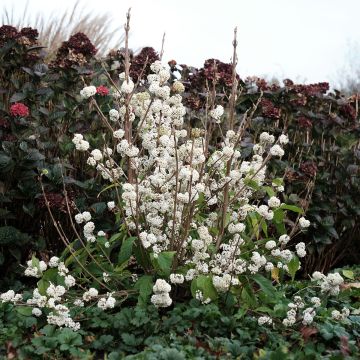
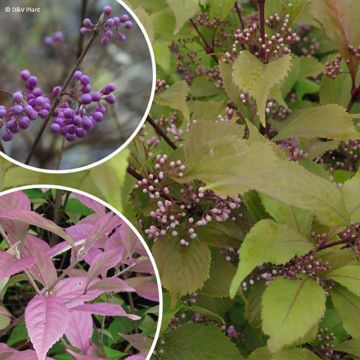
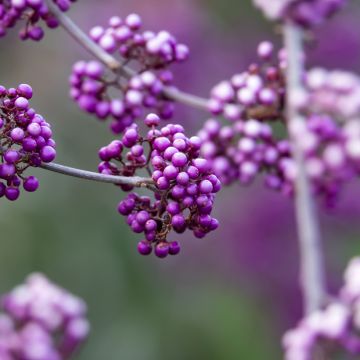

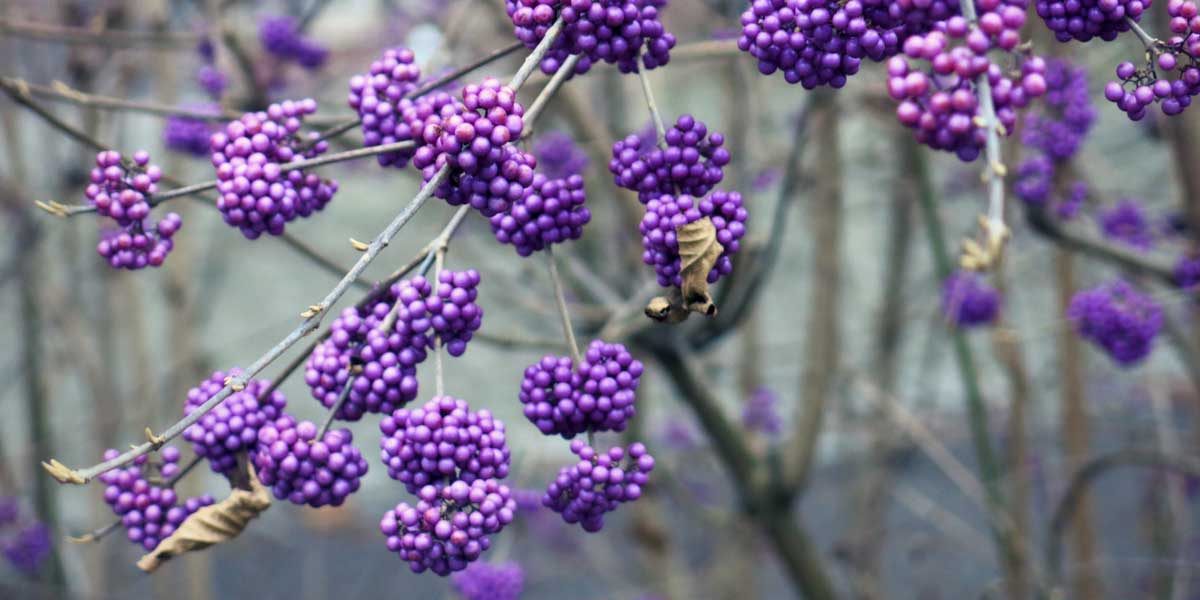

Comments